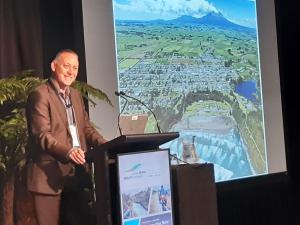Respiratory physician Lutz Beckert considers chronic obstructive pulmonary disease management, including the prevention of COPD, the importance of smoking cessation and pulmonary rehabilitation, and the lifesaving potential of addressing treatable traits. He also discusses the logic of inhaler therapy, moving from single therapy to dual and triple therapy when indicated, as well as other aspects of management
Thinking big or small: Rural sector talks pros and cons of national rural locality
Thinking big or small: Rural sector talks pros and cons of national rural locality

Everybody can see the health reforms lack detail; the health minister has admitted it. Fiona Cassie reports on the reforms’ apparent direction for rural health
- Rural health sector leaders see some promise in the Government’s planned locality networks, which will be communities of interest or populations of interest where it makes sense to plan services for them together.
- One idea is that rural health services might form a rural locality network as a community of interest across districts.
- Health minister Andrew Little says the reforms commit to equitable health outcomes for rural Māori, greater focus on technology to deliver care digitally, and a much more integrated health system.
Rural health is largely missing from official documents and speeches on the health reforms, which are instead described with rhetoric on communities and locality networks.
A search of the health reforms Cabinet paper finds the word “rural” mentioned only once – in a recommendation that new agency Health New Zealand’s regional chief executives ensure commissioning arms are responsive to the “particular challenges faced by rural communities”.
“Rural” also makes only one appearance in the reforms’ white paper. It says a centralised health system will lead to more consistency of care so “rural and small urban communities will have better access” to services such as emergency departments and acute maternity care, and “greater certainty” when more specialist care is needed.
The words “community” and “communities” appear 17 times in the health minister Andrew Little’s launch speech on 21 April, but “rural”, “remote” and “isolated” do not appear.
Mr Little acknowledged the lack of detail in his “high level reforms” when speaking to a National Rural Health Conference audience on 30 April. He said a lot of hard work was needed to “fill the gaps”, requiring engagement and consultation with the rural and wider health sector.
He also told the rural delegates he believed most of the sector’s RuralFest “calls for action” (made in November 2019) overlapped with his health reforms. This included equitable health outcomes for rural Māori, greater focus on using technology to deliver care digitally and a much more integrated health system.
When questioned on rural health and the new locality networks of providers that will be commissioned to provide primary and community health services, he reiterated that localities don’t have to be based on a geographic location and might be built around communities of interest.
At the conference, Health and Disability Review Transition Unit deputy head Martin Hefford was asked whether there were size restrictions on locality networks.
The review panel had referred to localities covering 20,000 to 100,000 people, Mr Hefford said, but the unit’s advice has been to “stay flexible”.
He says the locality concept is around a community of interest or a population of interest where it makes sense to plan services for them together.
He also asked the conference to consider whether rural health services might form a rural locality network as a community of interest across districts.
Rural hospital doctor and academic Garry Nixon says that, if the health reforms end up with rural localities looking like urban localities, then “we [will] have got it wrong”. Conference attendees applauded loudly.
They also quizzed Mr Little and Mr Hefford on the reforms’ answers to the sector’s ongoing funding and workforce problems.
Dr Nixon, a University of Otago associate professor and Dunstan Hospital doctor, says the “most reassuring” response was on rural locality networks.
He backs the concept of multiple rural localities linked together by a national rural locality network to provide a common voice on education and training. Looking similar to the Far North’s integrated Hauora Hokianga service, “That would give a much stronger rural voice nationally.”
Ōpōtiki GP Jo Scott-Jones isn’t keen for a national rural locality to be seen as the single voice for rural health.
Dr Scott-Jones, Pinnacle Midlands Health Network medical director, fears losing the local voice and losing the local communities’ needs within the national voice. But he says some rural health issues, such as workforce, funding and transport, need to be dealt with at a national level.
“So there’s potentially a role for a rurally focused district office of Health New Zealand that supports the needs of rural at a national level, without undermining what happens at the [rural] localities themselves.”
New Zealand Rural General Practice Network chair and locum GP Fiona Bolden says the creation of the new rural health body Hauora Taiwhenua is the “biggest opportunity” to really focus on things rural. (See “Seeking united rural voice: Network change” on page 12.)
“To have a pan-country, pan-professional health group working in partnership with Māori: who better to make the decisions around what happens to rural than that organisation?”
How rural hospitals will fit into rural localities is unknown, but Mr Hefford says planning and funding for such hospitals will come under Health NZ and the single health system plan.
He says whether rural hospitals are owned by community trusts or Health NZ shouldn’t matter so much; “what matters is whether they are adequately resourced and all part of one system”.
Integrated services are already under way in some rural areas and could readily adapt to become locality networks under the reforms.
Some of these are run by iwi or Māori providers or have existing partnerships with iwi and Māori.
Dr Nixon points to Hauora Hokianga as a potential rural locality, while Dr Scott-Jones points to Taupō and Tūrangi, where general practices, iwi provider Tuwharetoa Health and the rural hospital work well together.
The Taumarunui Community Kōkiri Trust became a case study of innovative integrated health services in the Health and Disability System Review Interim Report Pūrongo mō Tēnei Wā.
A kaupapa Māori service, it has three general practices across the Waikato, Ruapēhu and Waitomo districts, including Taumarunui’s main medical centre, which has 6800 enrolled patients, 52 per cent of them Māori.
Speaking at the National Rural Health Conference, Mr Little acknowledged the rural sector’s workforce and sustainability challenge, rural people’s worse health outcomes and that nearly a fifth of New Zealanders (19.4 per cent) currently live in rural places, with the proportion expected to grow slightly.
Reliable and fast digital connectivity, such as 4G and fibre, is needed to deliver digital care and is a problem in some areas, he said.
But the target of the rural broadband initiative is by 2023 to have digital connectivity possible for over 99 per cent of rural practices.










![Barbara Fountain, editor of New Zealand Doctor Rata Aotearoa, and Paul Hutchison, GP and senior medical clinician at Tāmaki Health [Image: Simon Maude]](/sites/default/files/styles/thumbnail_cropped_100/public/2025-03/Barbara%20Fountain%2C%20editor%20of%20New%20Zealand%20Doctor%20Rata%20Aotearoa%2C%20and%20Paul%20Hutchison%2C%20GP%20and%20senior%20medical%20clinician%20at%20T%C4%81maki%20Health%20CR%20Simon%20Maude.jpg?itok=-HbQ1EYA)
![Lori Peters, NP and advanced health improvement practitioner at Mahitahi Hauora, and Jasper Nacilla, NP at The Terrace Medical Centre in Wellington [Image: Simon Maude]](/sites/default/files/styles/thumbnail_cropped_100/public/2025-03/2.%20Lori%20Peters%2C%20NP%20and%20advanced%20HIP%20at%20Mahitahi%20Hauora%2C%20and%20Jasper%20Nacilla%2C%20NP%20at%20The%20Terrace%20Medical%20Centre%20in%20Wellington%20CR%20Simon%20Maude.jpg?itok=sUfbsSF1)
![Ministry of Social Development health and disability coordinator Liz Williams, regional health advisors Mary Mojel and Larah Takarangi, and health and disability coordinators Rebecca Staunton and Myint Than Htut [Image: Simon Maude]](/sites/default/files/styles/thumbnail_cropped_100/public/2025-03/3.%20Ministry%20of%20Social%20Development%27s%20Liz%20Williams%2C%20Mary%20Mojel%2C%20Larah%20Takarangi%2C%20Rebecca%20Staunton%20and%20Myint%20Than%20Htut%20CR%20Simon%20Maude.jpg?itok=9ceOujzC)
![Locum GP Helen Fisher, with Te Kuiti Medical Centre NP Bridget Woodney [Image: Simon Maude]](/sites/default/files/styles/thumbnail_cropped_100/public/2025-03/4.%20Locum%20GP%20Helen%20Fisher%2C%20with%20Te%20Kuiti%20Medical%20Centre%20NP%20Bridget%20Woodney%20CR%20Simon%20Maude.jpg?itok=TJeODetm)
![Ruby Faulkner, GPEP2, with David Small, GPEP3 from The Doctors Greenmeadows in Napier [Image: Simon Maude]](/sites/default/files/styles/thumbnail_cropped_100/public/2025-03/5.%20Ruby%20Faulkner%2C%20GPEP2%2C%20with%20David%20Small%2C%20GPEP3%20from%20The%20Doctors%20Greenmeadows%20in%20Napier%20CR%20Simon%20Maude.jpg?itok=B0u4wsIs)
![Rochelle Langton and Libby Thomas, marketing advisors at the Medical Protection Society [Image: Simon Maude]](/sites/default/files/styles/thumbnail_cropped_100/public/2025-03/6.%20Rochelle%20Langton%20and%20Libby%20Thomas%2C%20marketing%20advisors%20at%20the%20Medical%20Protection%20Society%20CR%20Simon%20Maude.jpg?itok=r52_Cf74)
![Specialist GP Lucy Gibberd, medical advisor at MPS, and Zara Bolam, urgent-care specialist at The Nest Health Centre in Inglewood [Image: Simon Maude]](/sites/default/files/styles/thumbnail_cropped_100/public/2025-03/7.%20Specialist%20GP%20Lucy%20Gibberd%2C%20medical%20advisor%20at%20MPS%2C%20and%20Zara%20Bolam%2C%20urgent-care%20specialist%20at%20The%20Nest%20Health%20Centre%20in%20Inglewood%20CR%20Simon%20Maude.jpg?itok=z8eVoBU3)
![Olivia Blackmore and Trudee Sharp, NPs at Gore Health Centre, and Gaylene Hastie, NP at Queenstown Medical Centre [Image: Simon Maude]](/sites/default/files/styles/thumbnail_cropped_100/public/2025-03/8.%20Olivia%20Blackmore%20and%20Trudee%20Sharp%2C%20NPs%20at%20Gore%20Health%20Centre%2C%20and%20Gaylene%20Hastie%2C%20NP%20at%20Queenstown%20Medical%20Centre%20CR%20Simon%20Maude.jpg?itok=Z6u9d0XH)
![Mary Toloa, specialist GP at Porirua and Union Community Health Service in Wellington, Mara Coler, clinical pharmacist at Tū Ora Compass Health, and Bhavna Mistry, specialist GP at Porirua and Union Community Health Service [Image: Simon Maude]](/sites/default/files/styles/thumbnail_cropped_100/public/2025-03/9.%20Mary%20Toloa%2C%20Porirua%20and%20Union%20Community%20Health%20Service%20in%20Wellington%2C%20Mara%20Coler%2C%20T%C5%AB%20Ora%20Compass%20Health%2C%20and%20Bhavna%20Mistry%2C%20PUCHS%20CR%20Simon%20Maude.jpg?itok=kpChr0cc)